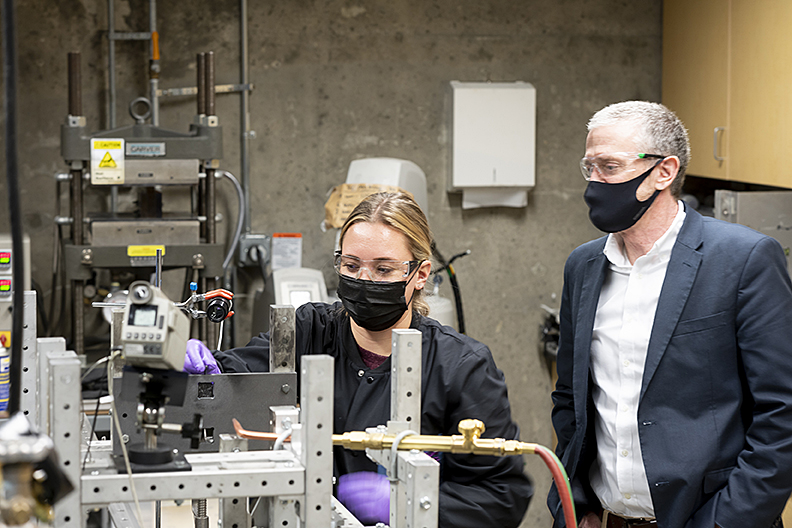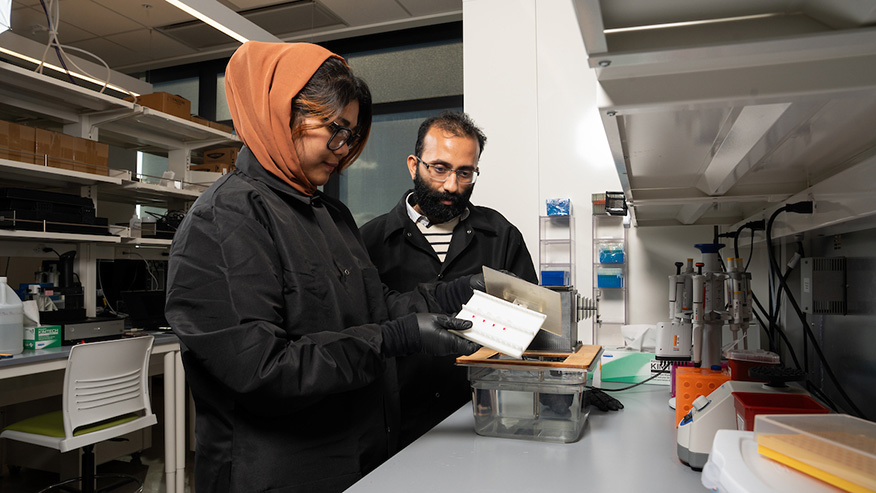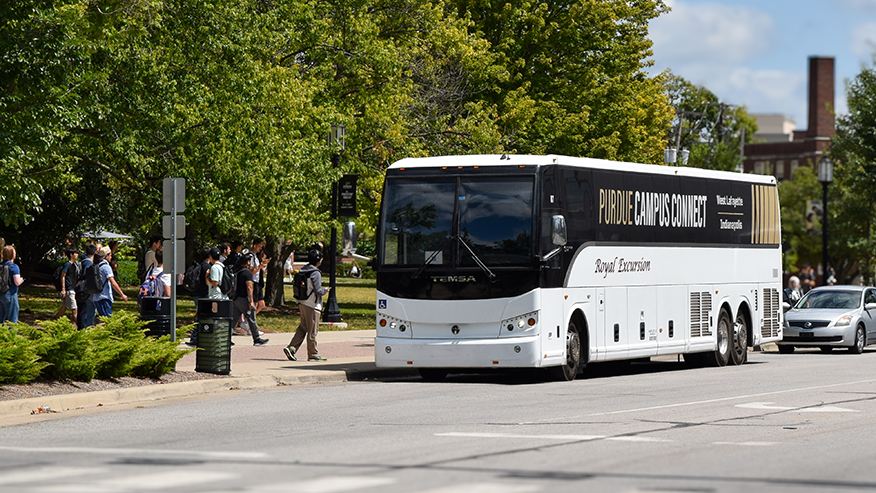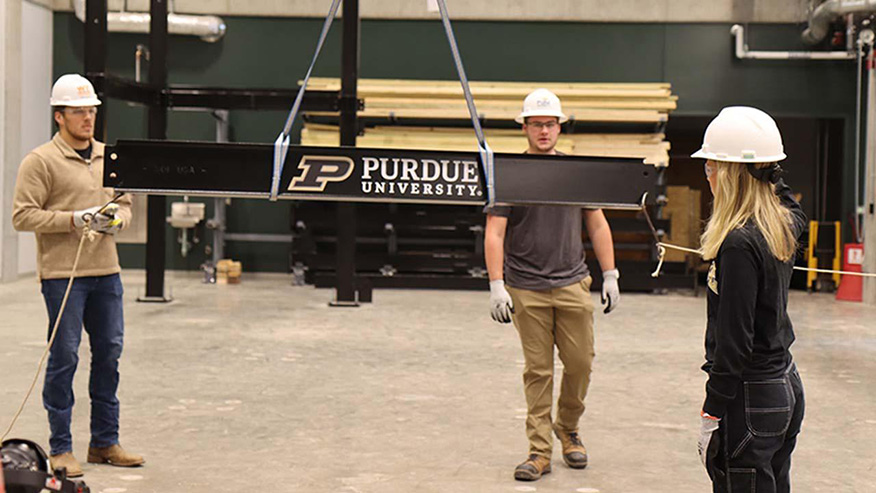Purdue hypersonics combines industry, academia in new materials and manufacturing center

Rod Trice, an engineer in Purdue’s School of Materials Engineering, works with graduate student Averyonna Kimery in the Trice Ceramics Lab to set-up an ablation experiment, subjecting a test material to extreme heat. (Purdue University photo/Vince Walter)
WEST LAFAYETTE, Ind. —
Purdue University will expand its hub of hypersonics research with the addition of a center focused on developing high-temperature materials and creating new manufacturing processes to build and join these materials, which will extend hypersonic vehicles’ capabilities and apply to other industries.
The new Hypersonics Advanced Manufacturing Technology Center (HAMTC) will be a single location at Purdue for industry partners, including GE Additive, Dynetics, Lockheed Martin, Aerojet Rocketdyne, GE Edison Works, Boeing and several small businesses, to work on materials and manufacturing innovations and provide access to testing capabilities at Purdue that would enable the U.S. to overtake near peer adversaries in the field.
Air resistance at hypersonic speeds (more than 5 times the speed of sound) creates extremely hot temperatures, causing surface level reactions that break down materials.
“When you heat up 3,000 degrees Fahrenheit, small differences in expansion can cause large stresses between components made of different materials that may result in failure of hypersonic vehicles,” said Michael Sangid, executive director of HAMTC and the Elmer F. Bruhn Professor of Aeronautics and Astronautics. “At HAMTC, we can essentially increase the temperature capabilities of materials via new compositions, create new manufacturing routes to produce complex geometrical designs, and join these dissimilar materials together, in order to meet the requirements of hypersonic environments.”

HAMTC will be located in the planned 65,000-square-foot Hypersonics and Applied Research Facility (HARF), which broke ground in late 2021. In addition to HAMTC, the $41 million HARF facility will house the only Mach 8 quiet wind tunnel in the world and the hypersonic pulse (HYPULSE) reflected shock/expansion tunnel. The tunnels recreate different scenarios, such as spacecraft re-entry or missile flight through the atmosphere, as well as replicating unique engine conditions for extremely high-speed propulsion.
GE Additive will be the primary partner for additive manufacturing at HAMTC, providing additive manufacturing machines that are customized to processes developed at the facility.
“The potential and opportunity for additive manufacturing in hypersonics is huge,” said Chris Schuppe, general manager – engineering and technology, GE Additive. “We are honored to be part of Purdue’s team supporting the Department of Defense in manufacturing research that will advance U.S. national security and competitiveness; we value results-driven, industry-academic collaboration in industrializing additive. Our team – many of whom are Purdue alums – are excited to get started.”
HAMTC is the first contract through the Purdue Applied Research Institute (PARI), the university’s new nonprofit applied research arm. OSD Manufacturing Science & Technology Program (MSTP) is partnering with NSWC Crane and National Security Technology Accelerator (NSTXL)’s Strategic & Spectrum Missions Advanced Resilient Trusted Systems (S2MARTS) to address these critical capabilities through advanced manufacturing of hypersonic technologies. PARI received a 30-month $18.6 million contract to directly address the hypersonic weapons development gaps.

Sangid said the opportunity to develop new material and manufacturing innovations with industry leaders is a “game-changer” for Purdue, extending beyond on-site collaboration. This center brings together a vertically integrated supply chain to enable the design, manufacturing, joining, and testing of hypersonic components and sub-systems in one location to reduce the time and cost necessary for development, as well as provide innovations through academic engagement.
“What is unique about this is our ability to work hand-in-hand with industry,” Sangid said. “We’ll have researchers and students work on real industrial and defense problems, while at the same time advances and transitioning innovations in high temperature materials and cutting-edge additive manufacturing.”
Material development and manufacturing at HAMTC offers applications for consumer products and a number of industry applications, including aerospace transportation, green energy, and nuclear applications. The hypersonic aspect also relates to space exploration, particularly vehicles traveling at hypersonic speeds as they re-enter the Earth’s atmosphere.
The contract for the new center began in December, further enhancing Purdue’s world-leading capabilities in hypersonics evaluation and testing.
Theresa Mayer, Purdue’s executive vice president for research and partnerships, and PARI’s vice chair and lead manager, said the creation of PARI is what made the large grant for HAMTC possible. PARI provides Purdue with advanced facilities and infrastructure and supports a large and complex portfolio of applied and translational research programs in support of the mission-driven needs of the Department of Defense.
“HAMTC will extend Purdue’s core competencies in hypersonics and enable us to work hand-in-hand with important partners, such as GE Additive, to address critical challenges facing this field by developing new materials and equipment,” Mayer said.
Purdue’s own recent investments in hypersonics position the university as a compelling partner for national defense projects from industry and government. Hypersonics is a critical area of focus under two of Purdue’s Next Moves strategic initiatives, which will advance the university’s competitive advantage.
This work continues Purdue’s focus toward creating a complex of hypersonics research and testing facilities to help the U.S. meet and exceed the progress of adversary nations. Success on this front can establish a crucial national asset to the nation.
HAMTC will be the only facility to integrate academia and industry from the start of the manufacturing process, Sangid said. Previous prototypes often took multiple years from development to long wait times for testing queues.
“We are vertically integrating our design/build/join/test capabilities here in our building,” Sangid said. “With the HYPULSE and Mach 8 tunnels, the idea is we can shorten the development cycles because we’ll not only have every step in the process under one roof, but we’re going to have the talent under one roof, as well.”
The main faculty supporting HAMTC are Rodney Trice, professor of materials engineering; Carson Slabaugh, associate professor of aeronautics and astronautics; Nathan Hartman, the Dauch Family Professor of Advanced Manufacturing and head of the Department of Computer Graphics Technology; Dan DeLaurentis, professor of aeronautics and astronautics and director of the Institute for Global Security and Defense Innovation; and Alexey Shashurin, associate professor of aeronautics and astronautics.
HARF is located in Purdue’s Discovery Park District, an innovation district for public and private research collaborations on research and commerce. Current tenants in the district include Rolls-Royce, Saab Defense and Security and SEL Purdue (Schweitzer Engineering Labs).
About Purdue University
Purdue University is a top public research institution developing practical solutions to today’s toughest challenges. Ranked in each of the last four years as one of the 10 Most Innovative universities in the United States by U.S. News & World Report, Purdue delivers world-changing research and out-of-this-world discovery. Committed to hands-on and online, real-world learning, Purdue offers a transformative education to all. Committed to affordability and accessibility, Purdue has frozen tuition and most fees at 2012-13 levels, enabling more students than ever to graduate debt-free. See how Purdue never stops in the persistent pursuit of the next giant leap at https://purdue.edu/.
About OSD ManTech
The Office of the Secretary of Defense’s (OSD) Manufacturing Science and Technology Program (MSTP) is a research and development investment portfolio focused on a set of identified joint, defense-critical, and sometimes high risk manufacturing technology areas. The portfolio focuses on cross-cutting defense manufacturing needs – those that are beyond the ability of a single Military Service to address – and stimulates the early development of manufacturing processes and enterprise business practices concurrent with science and technology development to achieve the largest cost-effective impact and facilitate the developments enabling capabilities to our Warfighters.
Writer, Media contact: Brian Huchel, bhuchel@purdue.edu
Sources: Michael Sangid
Theresa Mayer
Shaun Wootton
Note to journalists:
Images are available on Google Drive. Journalists visiting campus should follow visitor health guidelines.



